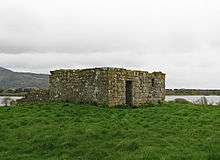St Serf's Inch Priory

The St Serf's Inch Priory (or Portmoak Priory) was a community of Augustinian canons based, initially at least, on St Serf's Inch in Loch Leven.
It was founded from St Andrews Cathedral Priory at the instigation of King David I of Scotland in 1150. There was a Scottish Céli Dé (or Culdee) establishment there in the first half of the 12th century, allegedly found by Bruide, son of Dargart, King of the Picts (696–706). Presumably it was dedicated to St Serb (Serf or Servanus), and there are indications that the Scottish establishment had a large collection of writings, mostly lost now or translated into Latin. When the Augustinian priory was founded in 1150, the Scottish monks were absorbed into the established and those who refused to join were to be expelled. The most famous prior undoubtedly was the chronicler, Andrew de Wyntoun who probably wrote his Orygynale Cronykil of Scotland on Loch Leven.[1] In the 15th century the priory begins to be referred to as "Portmoak", perhaps indicating that the canons had partially relocated there from the island. Following more than four centuries of Augustinian monastic life and the resignation of the last prior, the Protestant king, James VI of Scotland, granted the priory to St Leonard's College, St Andrews.
There are scant remains of the priory on the island (which is a bird sanctuary and not usually accessible), consisting of part of the possibly 11th century priory church, adapted in late times as a fishing bothy, and various foundations.
Burials
Bibliography
- Cowan, Ian B. & Easson, David E., Medieval Religious Houses: Scotland With an Appendix on the Houses in the Isle of Man, Second Edition, (London, 1976), p. 93
- Watt, D.E.R. & Shead, N.F. (eds.), The Heads of Religious Houses in Scotland from the 12th to the 16th Centuries, The Scottish Records Society, New Series, Volume 24, (Edinburgh, 2001), pp. 139–42
Notes
- ↑
 Herbermann, Charles, ed. (1913). "Lochleven". Catholic Encyclopedia. New York: Robert Appleton Company.
Herbermann, Charles, ed. (1913). "Lochleven". Catholic Encyclopedia. New York: Robert Appleton Company.